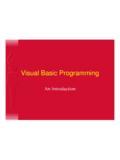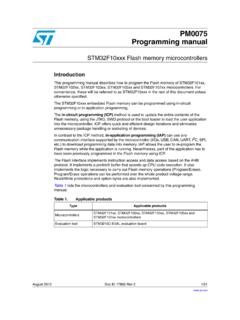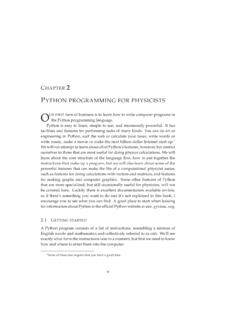Transcription of Thermocouple/ User Millivolt Input Module Manual
1 UserManualThermocouple/ Millivolt InputModule(Cat. No. 1794-IT8)Allen-BradleyBecause of the variety of uses for the products described in thispublication, those responsible for the application and use of thiscontrol equipment must satisfy themselves that all necessary stepshave been taken to assure that each application and use meets allperformance and safety requirements, including any applicable laws,regulations, codes and illustrations, charts, sample programs and layout examplesshown in this guide are intended solely for example. Since there aremany variables and requirements associated with any particularinstallation, Allen-Bradley does not assume responsibility or liability(to include intellectual property liability) for actual use based uponthe examples shown in this publication SGI , Safety Guidelines For TheApplication, Installation and Maintenance of Solid State Control (available from your local Allen-Bradley office)
2 Describes someimportant differences between solid-state equipment andelectromechanical devices which should be taken into considerationwhen applying products such as those described in this of the contents of this copyrighted publication, inwhole or in part, without written permission of Allen BradleyCompany, Inc. is this Manual we make notes to alert you to possibleinjury to people or damage to equipment under specificcircumstances.!ATTENTION: Identifies information about practicesor circumstances that can lead to personal injury ordeath, property damage, or economic helps you: identify a hazard avoid the hazard recognize the consequencesImportant:Identifies information that is especially important forsuccessful application and understanding of the.
3 We recommend you frequently backup your applicationprograms on appropriate storage medium to avoidpossible data , DeviceNetManager, and RediSTATION are trademarks of Allen-Bradley Company, , PLC 2, PLC 3, and PLC 5 are registered trademarks of Allen-Bradley Company, is a trademark of is a registered trademark of MicrosoftIBM is a registered trademark of International Business Machines, other brand and product names are trademarks or registered trademarks of their respective User Information u o n Publication April 1997 u o n The information below summarizes the changes to thecompany-wide templates since the last following new information has been added to this Manual .
4 The L type thermocouple selection has been added for use insome European procedures have been revised to eliminate 1 method inorder to better control calibration BarsThe areas in this Manual which are different from previous editionsare marked with change bars (as shown to the right of this paragraph)to indicate the addition of new or revised InformationUpdated Informationsoc iiSummary of ChangesPublication April 1997 Publication 1 Chapter Objectives 1 1.. The FLEX I/O System 1 1.. How FLEX I/O Analog Modules Communicate with ProgrammableControllers 1 1.. Typical Communication Between an Adapter and a Module 1 2.. Features of your Modules 1 3.. Chapter Summary 1 3.
5 Chapter 2 2 1.. Before You Install Your Input Module 2 1.. European Union Directive Compliance 2 1.. EMC Directive 2 1.. Low Voltage Directive 2 2.. Power Requirements 2 2.. Wiring the Terminal Base Units (1794-TB2 and -TB3 shown) 2 3.. Installing the Module 2 4.. Connecting Wiring for the Thermocouple/ mV Module 2 5.. Example of Millivolt Input Wiring to a 1794-TB3 Terminal Base Unit 2 7.. Example 3-wire thermocouple Wiring to a 1794-TB3T Temperature Terminal Base Unit 2 7.. Module Indicators 2 8.. Chapter Summary 2 8.. Chapter 3 Chapter Objectives 3 1.. Block Transfer programming 3 1.. Sample programs for FLEX I/O Analog Modules 3 2.. PLC-3 programming 3 2.. PLC-5 programming 3 3.
6 PLC-2 programming 3 4.. Chapter Summary 3 4.. Overview of Flex I/O andyour Thermocouple/ mVModuleHow to Install YourThermocouple/mV InputModuleModule ProgrammingTable of ContentsTable of ContentsiiPublication 4 Chapter Objectives 4 1.. Configuring Your Thermocouple/ mV Module 4 1.. Range Selection 4 2.. Input Scaling 4 2.. Hardware First Notch Filter 4 3.. Throughput in Normal Mode 4 3.. Reading Data From Your Module 4 4.. Mapping Data for the Analog Modules 4 4.. Thermocouple/ mV Input Module (1794-IT8) Image Table Mapping 4 4 Thermocouple/ mV Input Module (1794-IT8) Read 4 4.. Thermocouple/ mV Input Module (1794-IT8) Write 4 5.. Word/Bit Descriptions for the 1794-IT8 Thermocouple/ mVInput Module 4 5.
7 Chapter Summary 4 7.. Chapter 5 Chapter Objectives 5 1.. About DeviceNet Manager 5 1.. Polled I/O Structure 5 1.. Adapter Input Status Word 5 2.. System Throughput 5 3.. Mapping Data into the Image Table 5 3.. Thermocouple/ mV Input Module (1794-IT8) Image Table Mapping 5 3 Thermocouple/ mV Input Module (1794-IT8) Read 5 3.. Thermocouple/ mV Input Module (1794-IT8) Write 5 4.. Word/Bit Descriptions for the 1794-IT8 Thermocouple/ mVInput Module 5 4.. Defaults 5 7.. Chapter 6 Chapter Objective 6 1.. General Information 6 1.. Tools and Equipment 6 2.. Removing Lead Wire or thermocouple Extension Wire Resistance 6 2. Method 1 6 2.. Method 2 6 3.. Manually Calibrating your Thermocouple/ mV Input Module 6 4.
8 Flow Chart for Calibration Procedure 6 5.. Calibration Setups 6 6.. Wiring Connections for the thermocouple Module 6 6.. Read/Write Words for Calibration 6 7.. Offset Calibration 6 7.. Gain Calibration 6 8.. Writing Configuration toand Reading Status fromyour Module with a RemoteI/O AdapterHow Communication TakesPlace and I/O Image TableMapping with theDeviceNet AdapterCalibrating Your ModuleTable of ContentsiiiPublication Your Thermocouple/ mV Module using DeviceNetManagerSoftware (Cat. No. 1787-MGR) 6 9.. Offset Calibration 6 9.. Gain Calibration 6 11.. Appendix ASpecifications A 1.. Derating Curve A 2.. Resolution Curves for Thermocouples A 3.. Type B thermocouple A 3.
9 Type E thermocouple A 3.. Type C thermocouple A 4.. Type J thermocouple A 4.. Type K thermocouple A 5.. Type R thermocouple A 5.. Type S thermocouple A 6.. Type T thermocouple A 6.. Type N thermocouple A 7.. Worst Case Accuracy for the Thermocouple/ mV Module A 7.. Error Due to Open Circuit Current Through Loop Resistance A 8.. Worst Case Repeatability for the Thermocouple/ mV Input Module A 8 Appendix BGeneral B 1.. B (Platinum 30% Rhodium vs Platinum 6% Rhodium) TypeThermocouples B 1.. E (Nickel Chromium vs Copper Nickel <Constantan*>) TypeThermocouple B 2.. J (Iron vs Copper Nickel <Constantan*>) Type thermocouple B 2.. K (Nickel Chromium vs Nickel Aluminum) Type thermocouple B 4.
10 R (Platinum 13% Rhodium vs Platinum) andS (Platinum 10% Rhodium vs Platinum) Type Thermocouples B 5T (Copper vs Copper Nickel <Constantan*>) Type thermocouple B 5 SpecificationsThermocouple Restrictions(Extracted from NBSM onograph 125 (IPTS 68))Table of ContentsivPublication PrefacePublication April 1997 Using This ManualRead this preface to familiarize yourself with this Manual and tolearn how to use it properly and assume that you have previously used an Allen-Bradleyprogrammable controller, that you are familiar with its features, andthat you are familiar with the terminology we use. If not, read theuser Manual for your processor before reading this addition, if you are using this Module in a DeviceNet system, youmust be familiar with: DeviceNetManagerTM Software, cat.













